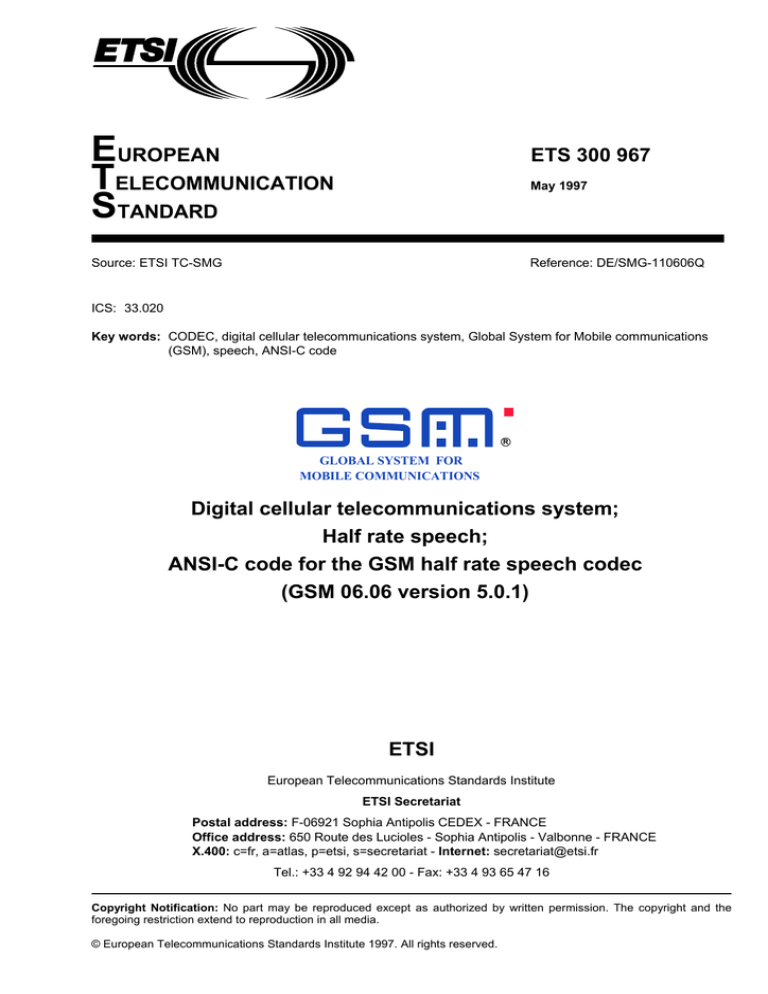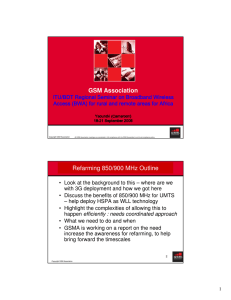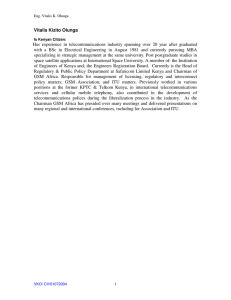
EUROPEAN
TELECOMMUNICATION
STANDARD
ETS 300 967
May 1997
Source: ETSI TC-SMG
Reference: DE/SMG-110606Q
ICS: 33.020
Key words: CODEC, digital cellular telecommunications system, Global System for Mobile communications
(GSM), speech, ANSI-C code
R
GLOBAL SYSTEM FOR
MOBILE COMMUNICATIONS
Digital cellular telecommunications system;
Half rate speech;
ANSI-C code for the GSM half rate speech codec
(GSM 06.06 version 5.0.1)
ETSI
European Telecommunications Standards Institute
ETSI Secretariat
Postal address: F-06921 Sophia Antipolis CEDEX - FRANCE
Office address: 650 Route des Lucioles - Sophia Antipolis - Valbonne - FRANCE
X.400: c=fr, a=atlas, p=etsi, s=secretariat - Internet: secretariat@etsi.fr
Tel.: +33 4 92 94 42 00 - Fax: +33 4 93 65 47 16
Copyright Notification: No part may be reproduced except as authorized by written permission. The copyright and the
foregoing restriction extend to reproduction in all media.
© European Telecommunications Standards Institute 1997. All rights reserved.
Page 2
ETS 300 967 (GSM 06.06 version 5.0.1): May 1997
Whilst every care has been taken in the preparation and publication of this document, errors in content,
typographical or otherwise, may occur. If you have comments concerning its accuracy, please write to
"ETSI Editing and Committee Support Dept." at the address shown on the title page.
Page 3
ETS 300 967 (GSM 06.06 version 5.0.1): May 1997
Contents
Foreword .......................................................................................................................................................5
1
Scope ..................................................................................................................................................7
2
Normative references..........................................................................................................................7
3
Definitions and abbreviations ..............................................................................................................7
3.1
Definitions ............................................................................................................................7
3.2
Abbreviations .......................................................................................................................8
4
C code structure ..................................................................................................................................8
4.1
Directory structure................................................................................................................8
4.2
Program execution...............................................................................................................9
4.3
Code hierarchy.....................................................................................................................9
5
ANSI-C code for the GSM half rate speech codec............................................................................16
History..........................................................................................................................................................17
Page 4
ETS 300 967 (GSM 06.06 version 5.0.1): May 1997
Blank page
Page 5
ETS 300 967 (GSM 06.06 version 5.0.1): May 1997
Foreword
This European Telecommunication Standard (ETS) has been produced by the Special Mobile Group
(SMG) Technical Committee of the European Telecommunications Standards Institute (ETSI).
A 3,5 inch diskette is attached to the back cover of this ETS, this diskette contains clause 5, the bit-exact
ANSI-C code for the GSM half rate codec.
This ETS specifies the half rate speech traffic channels for the digital cellular telecommunications system.
This ETS is part of ETSs series covering the half rate speech traffic channels as described below:
GSM 06.02
ETS 300 966: "Digital cellular telecommunications system; Half rate speech;
Half rate speech processing functions".
GSM 06.06
ETS 300 967: "Digital cellular telecommunications system; Half rate
speech; ANSI-C code for the GSM half rate speech codec".
GSM 06.07
ETS 300 968: "Digital cellular telecommunications system; Half rate speech;
Test sequences for the GSM half rate speech codec".
GSM 06.20
ETS 300 969: "Digital cellular telecommunications system; Half rate speech;
Half rate speech transcoding".
GSM 06.21
ETS 300 970: "Digital cellular telecommunications system; Half rate speech;
Substitution and muting of lost frames for half rate speech traffic channels".
GSM 06.22
ETS 300 971: "Digital cellular telecommunications system; Half rate speech;
Comfort noise aspects for half rate speech traffic channels".
GSM 06.41
ETS 300 972: "Digital cellular telecommunications system; Half rate speech;
Discontinuous Transmission (DTX) for half rate speech traffic channels".
GSM 06.42
ETS 300 973: "Digital cellular telecommunications system; Half rate speech;
Voice Activity Detector (VAD) for half rate speech traffic channels".
Transposition dates
Date of adoption:
4 April 1997
Date of latest announcement of this ETS (doa):
31 August 1997
Date of latest publication of new National Standard
or endorsement of this ETS (dop/e):
28 February 1998
Date of withdrawal of any conflicting National Standard (dow):
28 February 1998
Page 6
ETS 300 967 (GSM 06.06 version 5.0.1): May 1997
Blank page
Page 7
ETS 300 967 (GSM 06.06 version 5.0.1): May 1997
1
Scope
This European Telecommunication Standard (ETS) contains an electronic copy of the ANSI-C code for
the GSM half rate codec. The ANSI-C code is necessary for a bit exact implementation of the half rate
speech transcoder (GSM 06.20 (ETS 300 969) [2]), Voice Activity Detector (GSM 06.42
(ETS 300 973) [6]), comfort noise (GSM 06.22 (ETS 300 971) [4]), Discontinuous Transmission
(GSM 06.41 (ETS 300 972) [5]) and example solutions for substituting and muting of lost frames
(GSM 06.21 (ETS 300 970) [3])
2
Normative references
This ETS incorporates by dated and undated reference, provisions from other publications. These
normative references are cited at the appropriate places in the text and the publications are listed
hereafter. For dated references, subsequent amendments to or revisions of any of these publications
apply to this ETS only when incorporated in it by amendment or revision. For undated references, the
latest edition of the publication referred to applies.
[1]
GSM 01.04 (ETR 350): "Digital cellular telecommunications system (Phase 2+);
Abbreviations and acronyms".
[2]
GSM 06.20 (ETS 300 969): "Digital cellular telecommunications system; Half
rate speech; Half rate speech transcoding".
[3]
GSM 06.21 (ETS 300 970): "Digital cellular telecommunications system; Half
rate speech; Substitution and muting of lost frame for half rate speech traffic
channels".
[4]
GSM 06.22 (ETS 300 971): "Digital cellular telecommunications system; Half
rate speech; Comfort noise aspects for half rate speech traffic channels".
[5]
GSM 06.41 (ETS 300 972): "Digital cellular telecommunications system; Half
rate speech; Discontinuous Transmission (DTX) for half rate speech traffic
channels".
[6]
GSM 06.42 (ETS 300 973): "Digital cellular telecommunications system; Half
rate speech; Voice Activity Detector (VAD) for half rate speech traffic channels".
[7]
GSM 06.07 (ETS 300 968): "Digital cellular telecommunications system; Half
rate speech; Test sequences for the GSM half rate speech codec".
[8]
American National Standards Institute ANSI 9899 (1990): "Programming
Language - C (ISO)".
3
3.1
Definitions and abbreviations
Definitions
Definition of terms used in this ETS can be found in GSM 06.20 (ETS 300 969) [2], GSM 06.21
(ETS 300 970) [3], GSM 06.22 (ETS 300 971) [4], GSM 06.41 (ETS 300 972) [5] and GSM 06.42
(ETS 300 973) [6].
Page 8
ETS 300 967 (GSM 06.06 version 5.0.1): May 1997
3.2
Abbreviations
For the purposes of this ETS, the following abbreviations apply:
ANSI
DS-HD
ETS
GSM
I/O
ROM
American National Standards Institute
Double Sided High Density
European Telecommunication Standard
Global System for Mobile communications
Input/Output
Read Only Memory
For abbreviations not given in this subclause, see GSM 01.04 (ETR 350) [1].
4
C code structure
This clause gives an overview of the structure of the bit-exact C code and provides an overview of the
contents and organization of the 3,5 inch diskette attached to this ETS.
The C code has been verified on the following systems:
-
Sun Microsystem's 1) workstations and Sun Microsystems acc;
IBM 2) PC/AT compatible computers and Borlands Turbo-C 3) compiler;
VAX 4) and Digital Equipment Corporations CC.
ANSI-C 9899 [8] was selected as the programming language because portability was desirable. The data
medium for the code dissemination is MS-DOS 5) formatted 3,5 inch DS-HD floppy disk.
4.1
Directory structure
A listing of the directories is given in table 1.
Table 1: Directory structure listing
Directory name
\c
\d
\exec
\utils
readme.txt
Contents
C files and headers
example binary data input and output files
executables and makefiles
utility programs and the "reid" program
usage description of files
Size (bytes)
1 215 563
72 400
5 509
49 531
9 116
The C code diskette has one main directory and four subdirectories. The top directory has in it the file
readme.txt which explains the installation procedure, along with some miscellaneous descriptive
information regarding the code.
Below this directory, are the four subdirectories. The "c" subdirectory contains all the source code and
header files. This directory alone is essential, the others aid in the building, or testing of the code. All ROM
data is in this source directory. After installation, this directory can be made read only.
1)
Registered trade mark of Sun Microsystems
2)
Registered trade mark of International Business Machines
3)
Registered trade mark of Borland
4)
Registered trade mark of Digital Equipment Corporation
5)
Registered trade mark of Microsoft
Page 9
ETS 300 967 (GSM 06.06 version 5.0.1): May 1997
The "d" subdirectory contains all the speech coder installation verification data files. All of the data files are
written/read as 16 bit words, so these may require byte swapping on the target platform. All data and text
files are formatted such that they are correct for an IBM PC/AT compatible.
Final verification is to be performed using the GSM half rate test sequences described in GSM 06.07
(ETS 300 968) [7].
The "utils" subdirectory contains miscellaneous utilities which may be useful in the installation of the
software. Two programs are provided to transform text files: topcwild and tosnwild. The program topcwild
takes UNIX text files and converts them to pc text files. tosnwild does the opposite. The program swapbin
is also in this directory. This performs byte swapping on a binary data file. A fourth program, reid, is also
contained in this sub directory. This is the residual error insertion program which also provides the format
conversion between the encoder output file format and the decoder input file format.
The "exec" subdirectory contains the makefiles for the various platforms. Once the software is installed,
this directory will have a compiled version of gsm_hr (the bit-exact C executable), programs from the
"utils" directory, and all the object files.
The program gsm_hr is the name of the GSM half rate codec executable file.
4.2
Program execution
The GSM half rate speech codec is implemented as two separate programs:
-
(gsm_hr) speech codec;
(reid) encoder/decoder interface.
The gsm_hr program operates in one of two modes:
-
(0) encoding only;
(1) decoding only.
For encoding, the input is a binary speech file (*.inp) and the output is a binary encoded parameter file
(*.cod). For decoding, the input is a binary parameter files (*.dec) and the output is a binary synthesized
speech file (*.out). Note that the format for the parameter input file required for decoding (*.dec) is not the
same as the format of the parameter output file generated by encoding (*.cod). The reid program will
translate an *.cod file into an *.dec file (select error-free mode, EP0).
See the file readme.txt for more information on how to run the gsm_hr and reid programs.
4.3
Code hierarchy
Figures 1 to 7 are call graphs that show the functions used in the speech codec.
The encode call graph is broken down into six separate call graphs. Those sections, which are large, are
separated from the primary encode call tree and given their own call tree. Each vertical column represents
a call level. For example, main() is at level 0, encode() at level 1, speechEncoder() at level 2,
openLoopLagSearch() at level 3, getCCThreshold() at level 4, etc. The basic operations are not counted
as extending the depth, therefore the deepest level is this software is level 6.
Some items have been omitted from this call graph. All standard C functions: printf(), fwrite(), etc. have
been omitted. Also, no basic operations (add(), L_add(), mac(), etc.) or double precision extended
operations (e.g. L_mpy_ls()) appear in the graphs.
level_estimator
spectralPostFilter
signal_conceal_sub
pitchPrefilt
scaleExcite
level_calc
agcGain
IpcIir
lpcFir
g_coor1s
rs_rrNs
Figure 1: Speech decoder call graph
speechDecoder
rs_rr
v_con
b_con
fp_ex
sqroot
get_ipjj
g_corr1
res_eng
lagDecode
main
Interpolate check
decode
r0BasedEnergyShft
getSfrmLpc
a_sst
rcToADp
aflatRcDp
readDecFile
rxInterpR0Lpc
rcToCorrDpL
getPnBits
lininterpSid
gsQuant
avgGsHistQntz
lookupVq
errorConcealment
decoderHomingFrameTest
resetDecoder
para_conceal_speech_decoder
swSidDetection
linInterpSidShort
aToRc
Page 10
ETS 300 967 (GSM 06.06 version 5.0.1): May 1997
speechDecoderHostinterface
writeEncFile
fillBitAlloc
sfrmAnalysis
lpcFir
lpciir
openLoopLagSearch
res_eng
weightSpeechFrame
main
encode
swSpeechEncoder
getSfrmLpcTx
compResidEnergy
interpolateCheck
rcToADp
aFlatRcDp
hostEncoderInterface
getNWCoefs
resetEncoder
encoderHomingFrameTest
aflat
filt4_2nd
g_corr1
lpcZsIirp
lpcZsFir
lpcIrZsIiR
iir_d
aToRc
sqroot
Page 11
ETS 300 967 (GSM 06.06 version 5.0.1): May 1997
Figure 2: Speech encoder call graph
periodicity_update
Page 12
ETS 300 967 (GSM 06.06 version 5.0.1): May 1997
a flatN ewB arR ecu rsio n L
getN ex tV ec
setup Q ua nt
findB estInQ u a n tLis t
a flat
af latR ecu rs ion
setup P req
in it PB a rV B arL
initP B arF u llV B arF ullL
s iC o m fortN o ise
r 0Q uan t
va d_ algo rith m
rcT oC o rrD p L
fla t
sq root
co v3 2
Figure 3: Speech encoder LPC quantization call graph
Page 13
ETS 300 967 (GSM 06.06 version 5.0.1): May 1997
m axC C O verG W ithS ign
bestD elta
get_ipjj
q u an tL ag
G C in terp
fn B est_ C G
open LoopL agS earch
p itchL ags
C G InterpV alid
getC C T hreshold
fin dP eak
fn E x p2
r0 B ased E n erg y S h ft
fnL og 2
g_corr1s
Figure 4: Speech encoder open-loop lag search call graph
Page 14
ETS 300 967 (GSM 06.06 version 5.0.1): May 1997
lpc Iir
ga in Tw e ak
scal eE xite
g _ qu an t_ vl
g_ corr1
s q root
rs_ rrN s
h nw Filt
sfrm A na lysis
g_ corr2
lpc Z sIi r
v_ con
b_ con
v_s r ch
de corr
ge t_ ip jj
fp _e x
c losed Loop La g S ea rch
q ua nt La g
lp cZ iIir
m axC C O verG W ith Sign
Figure 5: Speech encoder subframe processing call graph
Page 15
ETS 300 967 (GSM 06.06 version 5.0.1): May 1997
getPnB its
aflatN ew B arR ecu rsion L
g etN ex tV ec
Ip cC o rrQ ntz
s etupQ ua nt
f indB est inQ u an tL is t
aflatR ecu rsion
siC om fo rt N ois e
r0 Q ua n t
setu p P reQ
av gC N ist
initP B arV B arl
gsQ ua n t
av gG s H istQ ntz
up d ateC N H ist
Figure 6: Comfort noise call graph
in itP B a rFullV B a rF ullL
Page 16
ETS 300 967 (GSM 06.06 version 5.0.1): May 1997
v ad_ han gov er
vad _ decision
th resho ld_ ad ap tio n
v ad_ a lgo rithm
ton e_ d etection
step _ u p
sp ectral_ com p ariso n
com p ute_ rav 1
p redicto r_ v alues
schu r_ recursio n
av erage_ acf
en erg y_ co m p u tatio n
Figure 7: Voice Activity Detector (VAD) call graph
5
ANSI-C code for the GSM half rate speech codec
NOTE:
This clause is contained in the attached diskette.
Page 17
ETS 300 967 (GSM 06.06 version 5.0.1): May 1997
History
Document history
December 1996
Unified Approval Procedure
May 1997
First Edition
ISBN 2-7437-1569-3
Dépôt légal : Mai 1997
UAP 60:
1996-12-02 to 1997-03-28


